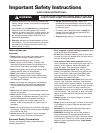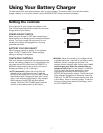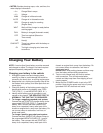
6
MINIMUM RECOMMENDED EXTENSION CORD
Length of Cord, in Feet 25 50 100 150
AWG* Size of Cord 14 12 10 8
*AWG=American Wire Gauge
Preparing your battery to be charged
It is important that you read and follow these guide-
lines while you are preparing to charge your battery.
• Make sure that you have a 12 volt or 6 volt lead-acid
battery. Set the volt/amp selector switch to match
the voltage rating of the battery to be charged.
• Clean the battery terminals. Be careful to keep
corrosion from getting in or around your eyes or on
your hands.
• If you have a battery with removable cell caps, if
required, add distilled water to each cell until the
battery acid reaches the level recommended by the
manufacturer. This will help purge excessive gases
from the cells. Be careful not to overfill. If you have a
sealed battery without cell caps, no action is neces-
sary. Continue to the next step listed below.
• Take time to read all battery manufacturer’s specific
precautions, such as removing or not removing
cell caps while charging, and recommended rates
of charge.
• Wear safety glasses. See additional “Personal
Safety Precautions” on page 2.
• Be sure that the area around the battery is well
ventilated while it is being charged. If ventilation is
poor, any gases emitted from the battery can be
manually blown away by using a piece of cardboard
or other non-metallic material as a fan.
• If it is necessary to remove the battery from the
vehicle to charge it, always remove the grounded
terminal from the battery first. A spark may be
caused if all accessories in the vehicle are not
completely turned off.
NOTE: A marine battery installed in a boat must be
removed and charged on shore.
Using an extension cord
The use of an extension cord is not recommended. If
you must use an extension cord, please make sure
that you follow these guidelines:
• Make sure the pins on the plug of the extension cord
are the same number, size, and shape as those of
the plug on the charger.
• Use only 3-conductor (grounded) extension cord
when necessary.
• Check that the extension cord is properly wired and
in good electrical condition.
Using the GFCI Outlet
• This charger includes two – GFCI (Ground Fault
Circuit Interrupter) outlets located on its back. The
purpose of a GFCI outlet is to quickly stop the flow of
electricity in the event a ground fault occurs on the
device plugged into the battery charger’s GFCI outlet.
Ground fault circuit interrupters (GFCI) can help
prevent electrical shock or electrocution.
• The GFCI outlets provide auxiliary power to 120V
devices that require less than 15 amps.
The GFCI must be tested before each use. To test:
1. Push the “Reset” button located on the GFCI
receptacle, first to assure normal GFCI operation.
2. Plug a nightlight (with an “ON/OFF” switch) or
other product (such as a lamp) into the GFCI
receptacle and turn the
product “ON.”
3. Push the “Test” button
located on the GFCI recep-
tacle. The nightlight or other
product should go “OFF.”
4. Push the “Reset” button, again. The light or other
product should go “ON” again.
NOTE: If the light or other product remains “ON” when
the “Test” button is pushed, the GFCI is not working
properly and should not be used. Call Customer
Service at 1-800-SEARS-64 (1-800-732-7764).
• The power cord must be plugged into a 3-prong
grounded 120V AC wall outlet for the GFCI opera-
tion to function. Ground fault circuit interrupters
(GFCI) can help prevent electrical shock or electro-
cution.
• If you are charging a battery, the GFCI outlet should
be limited to 3 amps of current draw until the charg-
ing functions are complete.
• The GFCI outlet should not be used while the
charger is in the ENGINE START mode.
• If using both GFCI outlets at the same time, the
amperage cannot exceed 15 amps of both devices
combined.
• Use the recommended minimum AWG (American
Wire Gauge) to be sure that wire size is large
enough for the rating of the charger.
RESET
Button
TEST
Button
GFCI OUTLET

















